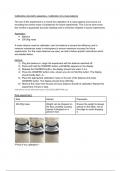Calibrating volumetric apparatus - Calibration of a mass balance
The aim of this experiment is to check the calibration of a mass balance and ensure it is
recording the correct mass of substances for future experiments. This is to be done every
few months to guarantee accurate readings and to minimise mistakes in future experiments.
Apparatus:
● Balance
● 200.00g mass
A mass balance must be calibrated, zero the balance to ensure the efficiency and to
measure substances mass in micrograms to ensure maximum accuracy for future
experiments. For the mass balances we used, we had to follow specific instructions which
are detailed below.
Method:
1) Plug the balance in, begin the experiment with the balance switched off.
2) Press and hold the ON/ZERO button until MENU appears on the display.
3) Release the ON/ZERO button, the display should now read, C.A.L.
4) Press the ON/ZERO button once, ensure you do not hold the button. The display
should briefly flash -C-.
5) Place the appropriate calibration mass on the pan of the balance and press
ON/ZERO button. The display should show 200.00g
6) Remove the mass from the pan and your balance should be calibrated. Repeat this
experiment 3 times in total.
Instructions can be referenced back to SCALECALIBRATION.com
Risk assessment:
Risk Hazard Precaution
200.00g mass Weight can be dropped on Ensure the weight is always
the floor, possibly causing placed on the table, not on
injuries if dropped on a the edge to avoid dropping
person's foot. it.
*Proof of my calibration ^
,Calibration weight used: 200g
Reading on mass balance: Trial 1: 200.00g
Trial 2: 200.00g
Trial 3: 199.99g
Average mean = 199.99g
The mass balance is accurate, it doesn’t need adjusting.
Percentage error: 0.01g
My experiment was carried out accurately with the reading of 200.00g. There was no
percentage error and as a result, the balance read the exact precise amount.
Two other groups recordings:
Group 1: 199.99g
Error:
Accuracy %= 199.99/ 200 * 100/1 = 99.995%
Error %= 0.05%
Group 2: 200.01g
Error:
Accuracy %= 200.01/200 *100/1 = 100.005%
Error %= 0.05%
Evaluation:
The percentage accuracy for my experiment was 199.99%, my percentage error was 0.01%.
My recordings were the most accurate out of my classes, one of the other groups recorded
100.005% accuray and the percentage error of 0.05%. Another group’s accuracy was
99.995%. Compared to my class recordings, mine are the most accurate. Ways I have made
my recordings more accurate is by securing the pads on the base of the balance, they had to
be evenly screwed on and the red dot had to be in the right direction. Without this, the mass
balance would record inaccurate recordings. Possibly, my classes results may have been
less accurate as they used a faulty balance or they didn’t identify the factors changing the
mass balance recordings. Furthermore, this should be made aware to the technician, who
can return the faulty equipment back to the manufacturer.
Calibrating volumetric apparatus - Calibration of a pipette
The aim of this practical is to check the calibration of a pipette and ensure its dispensing the
correct amounts of liquid for experiments. To guarantee the accuracy, repeat the calibration
every ¾ months.
Apparatus:
● 10ml glass pipette
● Distilled water
● Thermometer
● Pipette filler
● Balance
● 100ml beaker
● 250ml beaker
, Method:
1) Pour some distilled water into a beaker, aim for more than 20 ml.
2) Place a thermometer in the distilled water for 10 minutes and then record the
temperature.
3) Place an empty beaker on a mass balance, press the ZERO button and wait for the
balance to read 0.
4) Use the 10 ml glass pipette to pipette 10 ml volume of distilled water.
5) Place the pipetted amount of water into the empty beaker used to zero the mass
balance in step 2.
6) Use the mass balance to measure the mass of the 10 ml distilled water and the
beaker.
Temperature of water: 23◦C
Hazard Risk Precaution
Glassware Could smash and cause Wear goggles incase glass
wounds shatters into a person's eye,
ensure it is placed safely on
the table/handled with care,
present supervision from a
trained member of staff. All
protective equipment should
be worn, although for this
experiment gloves aren’t
necessary, it is useful to
start good health and safety
habits when carrying out
practicals.
Water Slipping can cause fractures Ensure to take care when
or increased chance of cuts handling glassware and
from glassware. water, walking slowly to
avoid bumping into peers, if
any smashes occur ensure
a wet floor sign is used and
the glassware is tidied up
quickly by a trained
professional.
Trial 1 Trial 2 Trial 3 Mean
Mass of beaker 73.74 73.82 73.85 73.80
(g)
Mass of beaker 83.55 85.39 83.79 84.24
and water (g)
Mass of water 9.81 11.57 9.94 9.875
(g)




